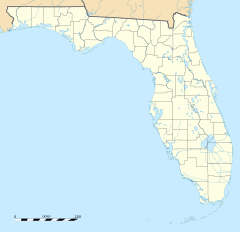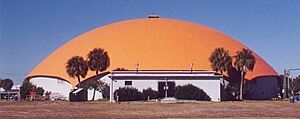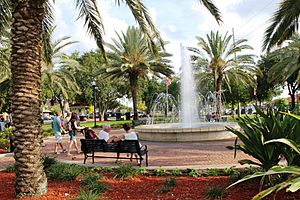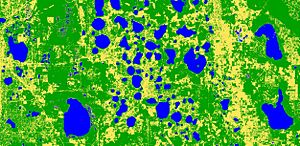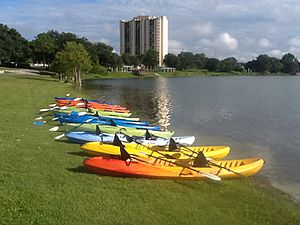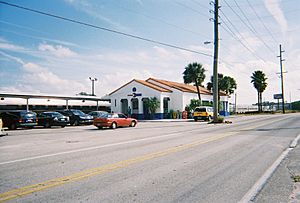Winter Haven, Florida facts for kids
Quick facts for kids
Winter Haven
|
||
|---|---|---|
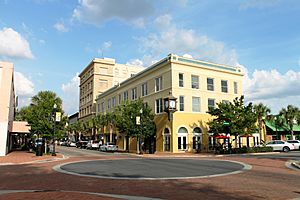
Central Avenue at the west side of downtown (Central Park is located behind the photo)
|
||
|
||
| Nickname(s):
"The Chain of Lakes City"
|
||
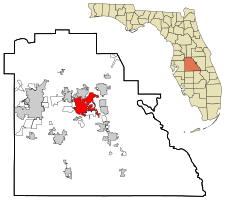 |
||
| Country | United States | |
| State | Florida | |
| County | Polk | |
| Platted (Harris Corners) |
1884-1885 | |
| Incorporated (town) | June 22, 1911 | |
| Incorporated (city) | November 27, 1923 | |
| Government | ||
| • Type | Commission–Manager | |
| Area | ||
| • City | 41.52 sq mi (107.53 km2) | |
| • Land | 32.84 sq mi (85.05 km2) | |
| • Water | 8.68 sq mi (22.47 km2) | |
| Elevation | 161 ft (49 m) | |
| Population
(2020)
|
||
| • City | 49,219 | |
| • Density | 1,498.75/sq mi (578.68/km2) | |
| • Urban | 253,251 (US: 161st) | |
| • Urban density | 1,774.5/sq mi (685.1/km2) | |
| • Metro | 725,046 (US: 80th) | |
| Time zone | UTC-5 (Eastern (EST)) | |
| • Summer (DST) | UTC-4 (EDT) | |
| Area code(s) | 863 | |
| FIPS code | 12-78275 | |
| GNIS feature ID | 2405773 | |
Winter Haven is a city in Polk County, Florida, United States. It's about 51 miles east of Tampa and 47 miles southwest of Orlando. The city is close to Lakeland. In 2020, Winter Haven had 49,219 people. This makes it the second-largest city in Polk County, after Lakeland. It's a main city in the Lakeland-Winter Haven, Florida Metropolitan Statistical Area.
Contents
Discover Winter Haven's Past
Early Inhabitants
Long ago, the Timucua and Calusa people lived in the Winter Haven area. Spanish explorers came in the 1500s. Their arrival brought war and sickness. Sadly, by the 1800s, these groups no longer existed. The Spanish claimed all of Florida for their country.
Later, in the 1800s, the Creek and Seminole tribes lived and hunted here. A Seminole leader named Chipco lived near Winter Haven. Some small battles of the Seminole Wars happened in this area.
How the City Grew
In 1819, the United States took control of Florida. New settlers were encouraged to move here in the 1840s. The U.S. government started mapping the area. Dr. John Westcott mapped many local lakes in 1849.
The first railroad arrived in 1883. It was built by Henry Plant's company. This railroad helped the area grow a lot. The town was first called Harris Corners. This was after F.A.K. Harris, who opened the first store. Later, people suggested the name Winter Haven. They liked the area's nice weather.
Becoming a City
By 1911, about 400 people lived here. On June 22, 1911, Winter Haven officially became a town. The famous Chain of Lakes canals were started in 1915. Florida grew quickly in the 1920s. But the Great Depression slowed things down.
On November 27, 1923, Winter Haven became a city. Winter Haven Hospital opened in 1926. Many beautiful homes were built then. Over 50 of these homes are now on the National Register of Historic Places. They are known for their special style. Most are in the Interlaken neighborhood. Winter Haven has four historic districts.
Modern Growth and Fun
In 1930, George W. Jenkins opened the first Publix supermarket in Winter Haven. Another big event was the opening of Cypress Gardens in 1936. Dick Pope Sr. and his wife, Julie Pope, created it. By the 1950s, Cypress Gardens was very famous. It had beautiful gardens and amazing water skiing shows. Many stars like Elvis Presley visited the park.
Cypress Gardens closed in 2009. But on January 21, 2010, Legoland Florida opened there! Legoland kept some of the old park's charm. This includes parts of the botanical garden and a water ski show.
The Orange Dome was a well-known building. It was built in 1964. It hosted the annual Citrus Festival. In 2012, it was taken down for a new project.
Pughsville: A Special Community
Pughsville was an important neighborhood in Winter Haven. African Americans built this community after the Civil War. It was named after Reverend Charles Pugh. He helped start Zion Hill Missionary Baptist Church. Pughsville had churches, a school, and small stores. People worked in citrus or for the government. This community was active from the 1900s to the 1950s. It produced Winter Haven's first African-American commissioner and mayor, Lemuel Geathers.
Winter Haven's Natural Beauty
Winter Haven covers about 25.4 square miles. About 7.7 square miles of this is water. The city is in the Central Florida Highlands. It has flat land and gentle hills. The average height above sea level is 146 feet. Winter Haven is also where the Peace River begins.
The Famous Lakes
Winter Haven is known as "The Chain of Lakes City." It has 50 lakes inside its borders! There are two main chains of lakes. The northern chain has nine lakes. The southern chain has sixteen lakes. All these lakes are connected by canals. In 2011, a new lock system connected the two chains.
Most lakes here formed like sinkholes. This happens when limestone underground dissolves. These are called "solution lakes." The lakes are full of life. You can see alligators, bald eagles, and great blue herons. Winter Haven is also a great place for bass fishing.
Weather in Winter Haven
Winter Haven has a humid subtropical climate. This means it's usually warm and humid. The average temperature is about 74.6°F. The city gets about 46 inches of rain each year. The rainiest months are June, July, August, and September. These months get more than half of the yearly rain. Winters are sunny and dry. High temperatures are around 72-76°F. Lows are about 51-55°F. It rarely gets frosty, maybe once a year.
People of Winter Haven
| Historical population | |||
|---|---|---|---|
| Census | Pop. | %± | |
| 1920 | 1,597 | — | |
| 1930 | 7,130 | 346.5% | |
| 1940 | 6,199 | −13.1% | |
| 1950 | 8,605 | 38.8% | |
| 1960 | 16,277 | 89.2% | |
| 1970 | 16,136 | −0.9% | |
| 1980 | 21,119 | 30.9% | |
| 1990 | 24,725 | 17.1% | |
| 2000 | 26,487 | 7.1% | |
| 2010 | 33,874 | 27.9% | |
| 2020 | 49,219 | 45.3% | |
| U.S. Decennial Census | |||
In 2020, Winter Haven had 49,219 people. There were 15,423 households living in the city.
Sports and Fun Activities
Winter Haven is home to many famous athletes. Olympic gold medal swimmers Rowdy Gaines and Kenneth Brokenburr grew up here. Four-time NBA all-star Otis Birdsong also grew up in Winter Haven. Welterweight boxing champion Andre Berto is another famous athlete from the city.
Winter Haven has great sports programs for kids. Winter Haven High School teams have won many championships. The Girls Varsity Basketball team won state titles in 2005, 2007, 2016, and 2017.
With so many lakes, fishing is very popular. But Winter Haven is most famous for water skiing and baseball.
Water Skiing History
Winter Haven has played a huge part in water skiing. Dick Pope Sr. used water skiing to promote Cypress Gardens in the 1930s. Water ski shows became a big part of the park. Dick Pope Sr. was the first person to jump on water skis in 1928. He jumped 25 feet over a ramp. He also invented tricks like the water ski human pyramid.
His son, Dick Pope Jr., helped make barefoot water skiing popular. Winter Haven is linked to 10 members of the Water Ski Hall of Fame and Museum. That's more than any other city! Today, many ski schools are in Winter Haven. You can see water skiers practicing on the lakes all year.
Baseball Spring Training
Winter Haven used to be a big place for Major League Baseball Spring Training. Famous players like Jimmie Foxx, Lou Gehrig, and Hank Aaron played here.
The Philadelphia Phillies were the first team to train in Winter Haven in 1928. They played at Denison Field. In 1966, the Boston Red Sox came to Winter Haven. They played at the new Chain of Lakes Park. The Red Sox stayed for 26 years.
Later, the Cleveland Indians moved to Winter Haven in 1992. They stayed for 16 springs. In 2020, the city decided to change Chain of Lakes Park. It will become new baseball fields and athletic areas.
Learning and Education
Winter Haven's public schools are run by Polk County Public Schools.
- All Saints' Academy
- Chain of Lakes Collegiate High School
- Chain of Lakes Elementary School
- Cypress Junction Montessori School
- Denison Middle School
- Eagle Lake Elementary School
- Elbert Elementary School
- Frank E. Brigham Academy Elementary School
- Garden Grove Elementary School
- Garner Elementary School
- Grace Lutheran School
- Inwood Elementary School
- Jewett Academy Middle School
- Jewett School of the Arts (K–8)
- John A. Snively Elementary School
- Lake Region High School
- Lake Shipp Elementary School
- Mark Wilcox Center
- Oasis Christian Academy
- Rachel's School for the Custodial Arts
- St. Joseph Catholic School
- St. Paul's Episcopal School
- Wahneta Elementary School
- Westwood Middle School
- Winter Haven Christian School
- Winter Haven High School
For higher education, Winter Haven has:
- Polk State College (PSC)
- Ridge Career Center
Famous People from Winter Haven
Many talented people have come from Winter Haven:
- Andre Berto, professional boxer
- Otis Birdsong, professional basketball player
- Kenny Brokenburr, Olympic gold medalist sprinter
- Rowdy Gaines, Olympic swimmer
- George Kalogridis, former President of Walt Disney World Resort
- Gene Leedy, famous architect
- Lobo, musician
- Trey Mancini, baseball player
- Jake Owen, country music singer
- Gram Parsons, musician
- Dick Pope Sr., founder of Cypress Gardens
- Dick Pope Jr., CEO of Cypress Gardens and Water Ski Hall of Famer
- John A. Snively, citrus business leader
- Jim Stafford, entertainer
- Don Thomson, water skier and navy pilot
- Constance Weldon, tuba player
- Ryan Yarbrough, baseball pitcher
Connecting with Winter Haven
Local News
The Winter Haven News Chief newspaper has served the community since 1911. In 2008, it joined with the Lakeland Ledger.
Getting Around
Winter Haven has several main roads:
 US 17 goes north to Lake Alfred and south to Bartow.
US 17 goes north to Lake Alfred and south to Bartow. US 27 is east of Winter Haven. It's a key road for Legoland Florida.
US 27 is east of Winter Haven. It's a key road for Legoland Florida. SR 540 is Cypress Gardens Boulevard. It goes west to Lakeland and east to US 27.
SR 540 is Cypress Gardens Boulevard. It goes west to Lakeland and east to US 27. SR 542 is Central Avenue in downtown. It goes east to Dundee.
SR 542 is Central Avenue in downtown. It goes east to Dundee. SR 544 is Havendale Boulevard. It connects to Auburndale and Haines City.
SR 544 is Havendale Boulevard. It connects to Auburndale and Haines City.
Downtown Winter Haven has a grid plan for its streets.
Public Transportation
Local buses are run by Winter Haven Area Transit and the Citrus Connection.
Air and Train Travel
Winter Haven's Gilbert Airport is just northwest of downtown. The Jack Browns Seaplane Base is also nearby.
Winter Haven has an Amtrak train station. You can catch the Floridian and Silver Meteor trains here.
Fun Places to Visit
Attractions
Healthcare
- Winter Haven Hospital
- Winter Haven Women's Hospital
- Bond Clinic
- Gessler Clinic
Sister City
Winter Haven has a sister city:
 Sambuca di Sicilia, Italy (since 1984). They became sister cities because of a Water Ski World Cup event held in Sambuca di Sicilia. Both cities share a love for this sport.
Sambuca di Sicilia, Italy (since 1984). They became sister cities because of a Water Ski World Cup event held in Sambuca di Sicilia. Both cities share a love for this sport.
See also
 In Spanish: Winter Haven (Florida) para niños
In Spanish: Winter Haven (Florida) para niños


